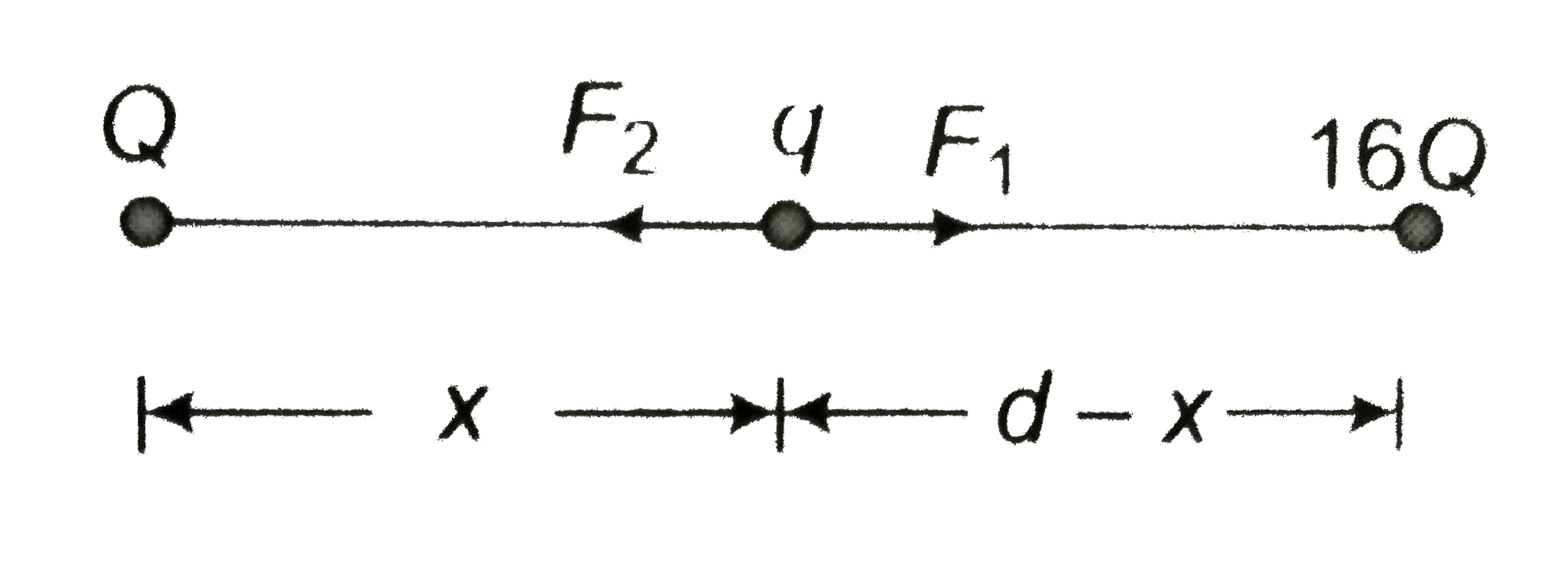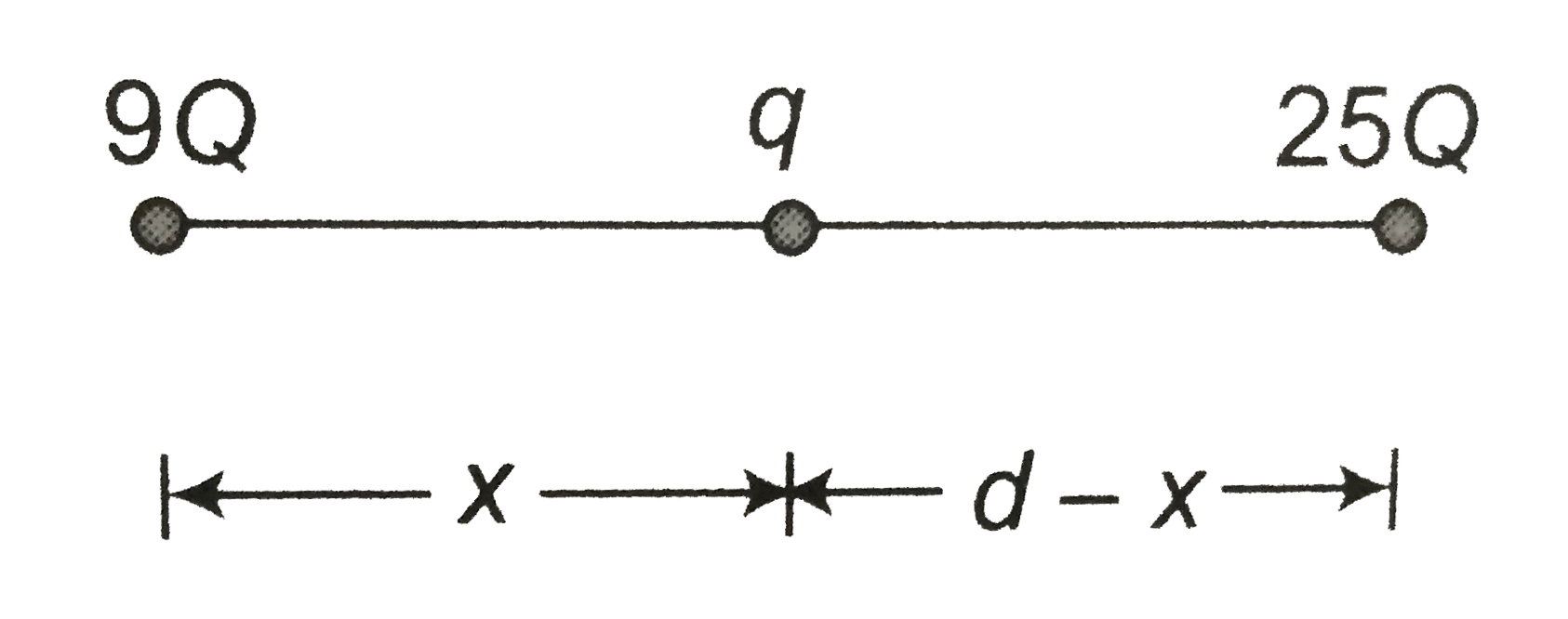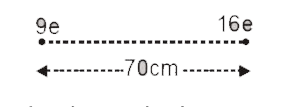(a) Two point charges Q and 16Q are fixed at separation d. Where should a third point charge be placed between them so that it experiences no force I.e. in equilibrium ?
(b) In the previous problem , if we replace Q by −Q , where should the third charge be placed on the joining the charges so that it is equilibrium ?
(c ) Three point charges Q,q and Q are placed at x=0,x=d/2 and x=d. Find q in terms of Q so that all charges are in equilibrium.
(d) Two point charges 9Q and 25Q are placed at separation d. Where should a third charge q be placed between them so that all charges are in equilibrium ? Also find the value of q and its nature.
(a) Let the third charge q be placed at distance x from Q.
Electric force on q:
Due to Q,F1=14π∈0Qqx2 , towards right
Due to 16Q,F2=14π∈016Qq(d−x)2 , towards left
Since net force on q is zero
F1=F2
1x2=16(d−x)2
Taking square root on both sides , we get
1x=4(d−x)⇒x=d5
Hence , the third charge be placed at distance d/5 from Q or at 4d/5 from 16Q.
(b) The third charge q cannot be placed between the charges , because the force on q due to −Q and 16Q will be in same direction , hence net force will not be zero.
The third charge can be placed either left of −Q or right of 16Q. Let q is placed x left of −Q.
Force on q:
Due to −Q,F1=14π∈0Qqx2 , towards right
Due to 16Q,F2=14π∈0Qqx2 , towards left
F1=F2
1x2=16(d+x)2⇒d+xx=4⇒x=d3
Let q be placed x right of 16Q.
(−Q,q):F1=14π∈016Qqx2 , towards right
F1=F2
1(d+x)2=16x2⇒xd+x=4⇒x=−4d3
i.e. the third charge be placed at 4d/3 left of 16Q or at d/3 left of −Q . (c ) All charges are in equilibrium i.e. net force on each charge is zero. To find value of q, put net force on Q (at (A or C) equal to zero.
Force on Q(atA)
Due to q,F1=14π∈0Qq(d/2)2 , towards left
Due to Q,F2=14π∈0Qqd2 , towards left
Net force on Q is zero i.e.
F1+F2=0
4Qq+Q2=0⇒q=−Q4
(d) All charges are in equilibrium i.e. net force on each is equal to zero.
Force at q:
14π∈09Qqx2=14π∈025Qq(d−x)2
9x2=25(d−x)2⇒3(d−x)=5x⇒x=3d8
Force at 9Q:
14π∈09Qqx2+14π∈09Q.25Qd2=0
q(3d/8)2=−25Qd2⇒q=−22564Q






Topper's Solved these Questions
Similar Questions
Two charges q and 3q are placed fixed on x-axis separated by distance 'd'. Where should a third charge 2q be placed such that it will not experience any force ?
View SolutionTwo charge q and –3q are placed fixed on x–axis separated by distance d. Where should a third charge2q be placed such that it will not experience any force ?
 View Solution
View Solution
Knowledge Check
- Question 1 - Select One
Two point charges +9e and +e are kept 16cm. Apart from each other. Where should a third charge q be placed between them so that the system is in equilibrium state:
A24cm form +9eB12cm from +9eC24cm from +eD12cm from +e - Question 2 - Select One
Two point metal charges−q and +2q are placed at a certain distance apart.Where should a third point charge be placed so that it is in equilibrium?
Aon the line joining the two charges on the right of +2qBon the line joining the two charge on the left of −qCbetween −q and +2qDat any point on the right bisector of the 1 line joining −q and +2q - Question 3 - Select One
Two point charges 2q and 8q are placed at a distance r apart. Where should a third charge −q be placed between them so that the electrical potential energy of the system is a minimum
Aat a distance of r/3 from 2qBat a distance of 2r/3 from 2qCat a distance of r/16 from 2qDNone of the above
Two chargea 2.0×10−6C are placed at a separation of 10 cm. where should a third charge be placed such that it experiences no net force due to these charges.
View SolutionTwo charge q and –3q are placed fixed on x–axis separated by distance d. Where should a third charge2q be placed such that it will not experience any force ?
 View Solution
View SolutionTwo charges Q and -3Q are placed fixed on x-axis separated by a distance 'd' Where should a third charge 2Q be placed such that it will not experience any force?
View SolutionTwo charge are placed as shown in fig. Where should be a third charge be
 View Solution
View SolutionTwo points charges +4q and +q are separated by distance r, where should a third point charge Q be placed that the whole system remains in equilibrium
View Solution

